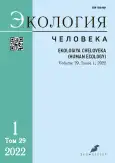Возрастные аспекты заболеваемости миопией на европейском севере России
- Авторы: Зеленцов Р.Н.1, Унгуряну Т.Н.1, Поскотинова Л.В.2
-
Учреждения:
- Северный государственный медицинский университет
- Федеральный исследовательский центр комплексного изучения Арктики имени академика Н.П. Лаверова
- Выпуск: Том 29, № 1 (2022)
- Страницы: 19-26
- Раздел: Статьи
- URL: https://bakhtiniada.ru/1728-0869/article/view/84128
- DOI: https://doi.org/10.17816/humeco84128
- ID: 84128
Цитировать
Полный текст
Аннотация
Введение. Выявление сенситивных возрастных периодов, когда происходит значимое увеличение впервые диагностированной миопии, особенно средней и высокой степени, важно для уточнения сроков диспансеризации и профилактики осложнений миопии с учётом возраста и пола на территории Европейского севера России.
Цель. Провести анализ первичной заболеваемости миопией в возрастно-половой структуре населения Архангельской области с учётом степени миопии, выявить возрастные группы потенциально нуждающиеся в диспансеризации и прогнозе течения близорукости.
Материал и методы. Проведён анализ первичной заболеваемости миопией населения в Архангельской области за 2009–2019 годы. Источником информации послужили медицинские карты пациентов, получающих медицинскую помощь в амбулаторных условиях (форма №025/у) у 14 288 пациентов и форма №12 «Сведения о числе заболеваний, зарегистрированных у пациентов, проживающих в районе обслуживания медицинской организации».
Результаты. Наибольший удельный вес случаев впервые выявленной миопии среди детского населения в Архангельской области приходится на возраст 7–14 лет. Выявлено преобладание новых случаев миопии слабой и средней степени в возрастной группе 10–14 лет у девочек (56,4% и 61,0%, соответственно) и у мальчиков (53,5% и 54,0%, соответственно), высокой степени — в возрастной группе 15–17 лет (51,5% у девочек и 51,9% у мальчиков). Наибольшая доля лиц с впервые выявленной миопией у взрослых приходится на возраст 18–29 лет как у женщин (35%), так и у мужчин (59,9%). В возрасте старше 60 лет у женщин миопия выявлялась в 2 раза чаще (9,7%), чем у мужчин (4,6%).
Заключение. Повышенное внимание в отношении выявляемости и профилактики миопии среди населения Архангельской области следует уделять детям в возрастных группах 10–14 и 15–17 лет, мужчинам в возрастной группе 18–29 лет, женщинам в группе 60 лет и старше, поскольку в этих группах происходит значительное нарастание удельного веса лиц с впервые выявленной миопией. Такие возрастные периоды с учётом пола можно рассматривать как сенситивные в отношении манифестации миопии.
Ключевые слова
Полный текст
Открыть статью на сайте журналаОб авторах
Роман Николаевич Зеленцов
Северный государственный медицинский университет
Автор, ответственный за переписку.
Email: zelentsovrn@gmail.com
ORCID iD: 0000-0002-4875-0535
кандидат медицинских наук, доцент
Россия, АрхангельскТатьяна Николаевна Унгуряну
Северный государственный медицинский университет
Email: unguryanu_tn@mail.ru
ORCID iD: 0000-0001-8936-7324
доктор медицинских наук, профессор
Россия, АрхангельскЛилия Владимировна Поскотинова
Федеральный исследовательский центр комплексного изучения Арктики имени академика Н.П. Лаверова
Email: liliya200572@mail.ru
ORCID iD: 0000-0002-7537-0837
доктор биологических наук, кандидат медицинских наук, доцент
Россия, АрхангельскСписок литературы
- Солонин Ю.Г., Бойко Е.Р. Медико-физиологические проблемы в Арктике // Известия Коми научного центра УРО РАН. 2017. № 4 (32). С. 33–40.
- Donovan L., Sankaridurg P., Ho A., Naduvilath T., et al. Myopia progression rates in urban children wearing single-vision spectacles // Optom Vis Sci. 2012. Vol. 89. Р. 27–32.
- Лантух В.В., Ким Т.Ю., Утюпина К.Ю., и др. Современные аспекты заболеваемости и течения миопии // Journal of Siberian Medical Sciences. 2014. № 3. С. 76.
- Зеленцов Р.Н., Поскотинова Л.В. Перспективы использования метода зрительных вызванных потенциалов при патологии зрительного анализатора у детей (обзор) // Журнал медико-биологических исследований. 2020. Т. 8, №3. С. 275–285.
- Rudnicka A.R., Kapetanakis V.V., Wathern A.K., et al. Global variations and time trends in the prevalence of childhood myopia, a systematic review and quantitative meta-analysis: implications for aetiology and early prevention. // Br. J. Ophthalmol. 2016. Vol. 100. P. 882–890.
- Guo X., Fu M., Ding X., et al. Significant axial elongation with minimal change in refraction in 3- to 6-uear-old Chinese preschoolers: The Shenzhen Kindergarten Eye Study // Ophthalmology. 2017. Vol. 124, N 12. Р. 1826–1838.
- Wu P.C., Chen C.T., Lin K.K., et al. Myopia prevention and outdoor light intensity in a school-based cluster randomized trial // Ophthalmology. 2018. Vol. 125, N 8. Р. 1239–1250.
- Hsu C.C., Huang N., Lin P.Y., et al. Risk factors for myopia progression in second-grade primary school children in Taipei: a population-based cohort study // Br J Ophthalmol. 2017. Vol. 101, N 12. Р. 1611–1617.
- Sun J.T., An M., Yan X.B., et al. Prevalence and Related Factors for Myopia in School-Aged Children in Qingdao // J Ophthalmol. 2018. Vol. 2018. P. 978–987.
- Flitcroft D.I. The complex interactions of retinal, optical and environmental factors in myopia aetiology // Progress in Retinal and Eye Research. 2012. Vol. 9. Р. 622–660.
- Holden B.A., Fricke T.R., Wilson D.A., et al. Global Prevalence of Myopia and High Myopia and Temporal Trends from 2000 through 2050 // Ophthalmology. 2016. Vol. 123, N 5. Р. 1036–1042.
- Wu P.C., Huang H.M., Yu H.J., et al. Epidemiology of Myopia // Asia Pac J Ophthalmol (Phila). 2016. Vol. 5, N 6. Р. 386–393.
- Какорина Е.П. Заболеваемость населения по субъектам РФ по данным на 2007 год: Доклад / Министерство здравоохранения и социального развития Российской Федерации, Департамент развития медицинской помощи и курортного дела и ФГУ "ЦНИИОИЗ Минздравсоцразвития России". М., 2008.
- Либман Е.С., Шахова Е.В. Слепота и инвалидность вследствие патологии органа зрения в России // Вестник офтальмологии. 2006, Т. 122, № 1. С. 35–37.
- Федеральные клинические рекомендации. Миопия. Одобрено Научно-практическим Советом Минздрава России. 2020 год.
- Пилягина Н.А., Фабрикантов О.Л. Заболеваемость миопией в Тамбовской области // Вестник российских университетов. Математика. 2017. Т. 22, № 4. С. 693–698.
- Выдров А.С., Комаровских Е.Н. Структура заболеваемости близорукостью в Амурской области // Современные проблемы науки и образования. 2013. № 1.
- Zadnik K., Sinnott L.T., Cotter S.A., et al. Collaborative Longitudinal Evaluation of E, Refractive Error Study G. Prediction of Juvenile-Onset Myopia // JAMA Ophthalmol. 2015. Vol. 133. Р. 683–689.
- Балль А.А. Миопия и синдром недифференцированной дисплазии соединительной ткани // Вестник совета молодых учёных и специалистов Челябинской области. 2018. Т. 2, № 3. С. 11–15.
- Wolffsohn J.S., Flitcroft D.I., Gifford K.L., et al. IMI — Myopia Control Reports Overview and Introduction // Invest Ophthalmol Vis Sci. 2019. Vol. 60, N 3. P. M1–M19.
Дополнительные файлы








